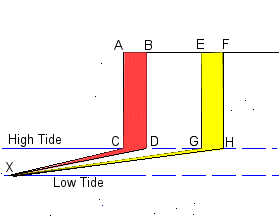Cliff retreat in resistant rock.
Please start at Evolution.html
This is a well-known form of slope evolution.
Conditions:
(a) Sea level is stable.
(b) Marine erosion takes place at the foot of the cliff between mean high tide and low tide level.
(c) The rock is strong enough to support a vertical slope.
(d) Marine erosion is much faster than weathering of the cliff face.
(e) The cliff retreats by rock falls triggered by marine erosion. The free fall of debris produced by weathering is insignificant.
Explanation of the simulation:
(a) Marine erosion occurs between mean high tide level and low tide level to produce a notch.
(b) Eventually the overhanging rock collapses to form a rock fall.
(c) Marine erosion gradually removes the rock fall.
(d) The debris is dragged across the wavecut platform and out to sea.
(e) The debris erodes and lowers the wavecut platform. The debris is ground down by attrition and becomes finer in texture.
(f) The debris piles up below the low tide level to produce an offshore terrace.
This process is repeated over and over again as the cliff moves inland, maintaining its vertical slope, and the wavecut platform gets longer and gentler.
There is no reason for any change in the process to occur as the diagram below indicates:
Diagram showing why conditions do not change as a vertical cliff retreats inland.

The amount of work the waves have to do as the cliff retreats through a given distance, like a metre, is always the same. So if AB and EF are both a metre then ABCD=EFGH and CDX=GHX. The base of the triangles remains the same as does the height of the triangles - which is the distance between mean high tide and low tide levels. (The area of a triangle is half the base multiplied by the height.) The red area is the same as the yellow area.
There is no reason why the cliff should ever flatten if conditions remain the same.
|
